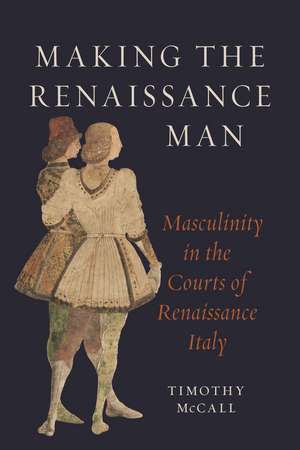Making the Renaissance Man: Masculinity in the Courts of Renaissance Italy
Autor Timothy McCallen Limba Engleză Hardback – 5 dec 2023
Making the Renaissance Man explores the images, objects, and experiences that fashioned men and masculinity in the courts of fifteenth-century Italy. Across the peninsula, Italian princes fought each other in fierce battles and spectacular jousts, seduced mistresses, flaunted splendor in lavish rituals of knighting, and demonstrated prowess through the hunt—all ostentatious performances of masculinity and the drive to rule. Hardly frivolous pastimes, these activities were essential displays of privilege and virility; indeed, violence underlay the cultural veneer of the Italian Renaissance. Timothy McCall investigates representations and ideals of manhood in this time and provides a historically grounded and gorgeously illustrated account of how male identity and sexuality proclaimed power during a century crucial to the formation of Early Modern Europe.
Preț: 167.78 lei
Nou
Puncte Express: 252
Preț estimativ în valută:
32.10€ • 33.45$ • 26.58£
32.10€ • 33.45$ • 26.58£
Carte disponibilă
Livrare economică 13-20 martie
Livrare express 27 februarie-05 martie pentru 64.22 lei
Preluare comenzi: 021 569.72.76
Specificații
ISBN-13: 9781789147858
ISBN-10: 1789147859
Pagini: 280
Ilustrații: 98 color plates, 8 halftones
Dimensiuni: 159 x 235 x 25 mm
Greutate: 1.06 kg
Editura: REAKTION BOOKS
Colecția Reaktion Books
ISBN-10: 1789147859
Pagini: 280
Ilustrații: 98 color plates, 8 halftones
Dimensiuni: 159 x 235 x 25 mm
Greutate: 1.06 kg
Editura: REAKTION BOOKS
Colecția Reaktion Books
Notă biografică
Timothy McCall is associate professor of art history at Villanova University, Philadelphia. He is coeditor of Visual Cultures of Secrecy in Early Modern Europe and the author of Brilliant Bodies: Fashioning Courtly Men in Early Renaissance Italy.
Cuprins
INTRODUCTION: Making Renaissance Men
CHAPTER 1: Chivalry and Courtly Masculinity
CHAPTER 2: Aristocratic Animals and Men at Court
CHAPTER 3: Courtly Mistresses: Representation and Power
CHAPTER 4: The Girl with an Ermine Between Men: Cecilia Gallerani, Leonardo da Vinci and Ludovico Sforza
CHAPTER 5: Borso d’Este and the History of Lordly Sexuality
REFERENCES
SELECT BIBLIOGRAPHY
ACKNOWLEDGEMENTS
PHOTO ACKNOWLEDGEMENTS
INDEX
CHAPTER 1: Chivalry and Courtly Masculinity
CHAPTER 2: Aristocratic Animals and Men at Court
CHAPTER 3: Courtly Mistresses: Representation and Power
CHAPTER 4: The Girl with an Ermine Between Men: Cecilia Gallerani, Leonardo da Vinci and Ludovico Sforza
CHAPTER 5: Borso d’Este and the History of Lordly Sexuality
REFERENCES
SELECT BIBLIOGRAPHY
ACKNOWLEDGEMENTS
PHOTO ACKNOWLEDGEMENTS
INDEX
Recenzii
"Focused on fifteenth-century Italy, this book boldly reassesses the cliched notion of a unified and cohesive prototype of the Renaissance man. McCall examines this concept through a series of well-selected examples and a refreshingly interdisciplinary method of analysis to understand how different models of masculinity and multiple signifiers of manhood have emerged throughout the Quattrocento. These contributed to consolidating a gendered, elite-based network of social prominence and political control. Drawing from theorists of gender and sexuality, such as R. W. Connell, Jack Halberstam, and Judith Butler, the volume delves into the material culture of the period, verifying the ways in which a wide range of items—paintings, medals, architecture, clothes, jewels, and even animals—have functioned as ‘markers of manhood,’ helping to fashion and validate tangible ideals of lordly masculinity. With artfully interwoven arguments, this illustrated book's five chapters address different aspects of this intricate process of symbolic construction, persuasively suggesting that masculine authority was sanctioned not only in opposition to femininity, but also through the articulation of homosocial spaces and courtly venues in which men could compete with and dominate other men in performative displays of power. Recommended."
"McCall explores Renaissance court culture as a ritual process for the formation of elite males. Chivalry, humanist pedagogy, jousting and hunting, oath-taking and lovemaking were mimetic activities, centered on the glamorous and eroticized male body—the dominant subject of court art in Ferrara, Mantua, Naples, and Milan. While focusing on the relations between princes and their male relations, rivals, and entourages, Making the Renaissance Man is no less attentive to women at the courts. Women like Cecilia Gallerani, the teenage mistress of Ludovico Sforza famously portrayed by Leonardo da Vinci, emerge here as a state of exception in this erotic economy of power, throwing new light on portraiture as a means of negotiating a perilous and mirage-like world."
"McCall’s groundbreaking research unveils aristocratic men’s love for resplendent clothes and jewellery in a foundational period for the history of fashion."
“Gathering together a marvelous treasury of visual and literary sources, McCall looks beneath the civilized sheen of the heroic renaissance man to reveal the brutality of everyday aristocratic life, a precarious and often violent world dominated by toxic rivalries, strained matrimonial alliances, and lavish material display. Teeming with gossip about badly behaved lords, knights in shining armor, clever young brides and mistresses, conniving parents and patrons, and the circumspect artists these men and women commissioned to project, reinforce, and normalize their extreme power and privilege, Making the Renaissance Man brings to life the multisensory world of Italian Renaissance courts.”
